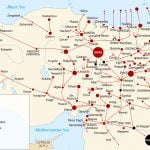Armenian mythology is a rich tapestry of gods, heroes, and mythical creatures that have shaped the cultural heritage of the Armenian people. These mythical beings, with their extraordinary powers and symbolism, continue to inspire stories and legends passed down through generations. This page will take you on a journey through some of the most fascinating mythical creatures in Armenian mythology, examining their roles, symbolism, and influence on the cultural landscape of Armenia
Aralezs (Aralezner)
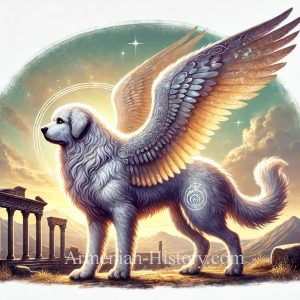
Aralezs are among the oldest deities in Armenian mythology, often depicted as dog-like creatures with the miraculous ability to revive the fallen by licking their wounds. Believed to inhabit the peaks of sacred mountains, these gods were revered as symbols of healing and resurrection. Armenian warriors would call upon the Aralezs for protection and guidance before going into battle, and legends claim that the bravest soldiers were sometimes brought back to life by these celestial beings.
Vishaps (Dragons)
Vishaps, the Armenian dragons, are prominent figures in Armenian folklore. These serpent-like creatures dwell in mountains, lakes, and clouds, and are capable of causing floods and storms. Vishaps symbolize both destruction and guardianship, depending on the story. Some legends depict Vishaps as protectors of treasure and knowledge, while others cast them as fearsome adversaries, often defeated by heroes like Vahagn, the god of war and thunder.
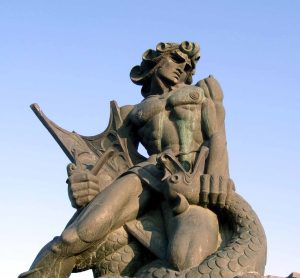
Azhdahak (The Great Serpent)
Azhdahak is a mythical serpent or dragon figure in Armenian mythology, often seen as a symbol of chaos and darkness. Legends tell of a great battle between Azhdahak and the Armenian god Vahagn, in which Vahagn triumphs over the serpent, symbolizing the victory of light and order over darkness and chaos.
Dragons, similar to Armenian Vishaps, also appear in many other cultures’ mythologies around the world. Their origins and symbolism differ across regions, making them one of the most universally recognized mythical creatures.
Vishapakar (Vishap Stones)
Vishapakar, also known as “dragon stones,” are ancient monolithic stones found in Armenia, often associated with the veneration of Vishaps. These stones are typically carved with depictions of fish, serpents, or other animals, symbolizing water sources and fertility. Vishapakars were placed near springs or water sources, as they were believed to have protective powers and were linked to the worship of Vishaps.
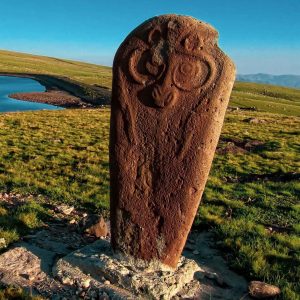
Vishapakars, dating back to the Bronze Age, serve as a testament to the ancient Armenian people’s connection with nature and their belief in the supernatural powers of Vishaps. These mysterious stones remain an important part of Armenia’s archaeological heritage and are a physical link to the mythical creatures of Armenian folklore.
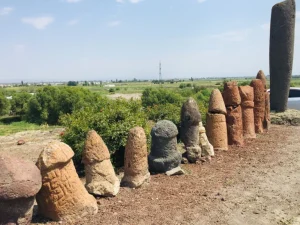
Devs

In Armenian mythology, Devs (also rendered as Divs) are fearsome supernatural entities often associated with chaos, destruction, and moral corruption. Their origins trace back to ancient Indo-European cosmologies and were later reshaped under Zoroastrian influence, where they became aligned with the forces of darkness in stark opposition to divine order. In this dualistic framework, devs function as adversaries of the gods, mirroring the eternal struggle between light and shadow—a central theme in Armenian mythological tradition.
Devs are typically portrayed as monstrous, demonic beings, residing in remote and treacherous locations such as mountaintops, deep caverns, or the underworld. Their domains symbolize the liminal and chaotic spaces that threaten human civilization and spiritual harmony. These creatures embody forces that disrupt cosmic balance and challenge the will of the divine.
Throughout Armenian epic narratives and folk traditions, devs are depicted as antagonists who must be overcome by heroic figures or gods, such as the thunder-god Vahagn, renowned for his fiery birth and demon-slaying prowess. Their presence in these tales underscores a broader moral and spiritual allegory—where divine forces represent enlightenment, order, and justice, while devs symbolize ignorance, disarray, and malice.
What distinguishes Armenian devs from similar figures in other traditions—such as the Persian divs or Mesopotamian demons—is the localized cultural adaptation of their traits and narrative roles. While they share demonological roots with their regional counterparts, Armenian devs evolved unique characteristics, often absorbing aspects of native folklore and heroic legend. In some accounts, they are even described as cunning shape-shifters or sorcerers with powers that rival the gods, adding further complexity to their mythological profile.
Their recurrent defeat at the hands of gods or virtuous heroes reflects the Armenian mythological worldview, where the triumph of light over darkness is not only inevitable but necessary for the preservation of cosmic equilibrium. In this way, devs serve both as symbolic threats and narrative catalysts—reminding audiences of the fragility of order and the enduring need for courage, wisdom, and divine guidance
Nhangs (Water Creatures)
Nhangs are shape-shifting water spirits that are part of Armenian mythology. These creatures are said to dwell in rivers, lakes, and seas, with the ability to transform into a variety of forms, including serpents, sea creatures, and even humans. In some legends, Nhangs are depicted as dangerous beings capable of drowning people, while in others, they possess healing and protective qualities, depending on their interaction with humans.
Pahapan (Guardians)
Pahapan, meaning “guardian,” is a type of protective spirit in Armenian folklore. These creatures are believed to watch over specific locations, such as sacred sites, forests, and rivers. Pahapan are seen as benevolent beings who protect against evil forces and maintain the balance of nature.
Conclusion: The Legacy of Armenian Mythical Creatures

Armenian mythology is rich with mythical creatures and epic heroes that embody the forces of nature, morality, and the eternal battle between good and evil. These creatures, whether they are revered as protectors or feared as destroyers, continue to hold a significant place in Armenian cultural heritage and folklore. Understanding these mythical beings offers insight into the values, fears, and hopes of the ancient Armenian people, connecting us to a profound and ancient worldview.




